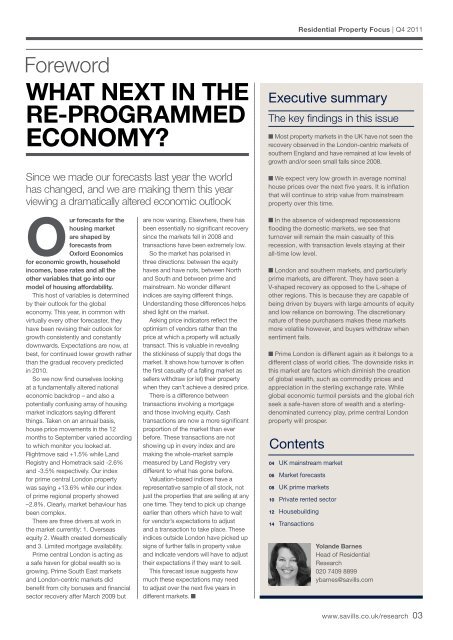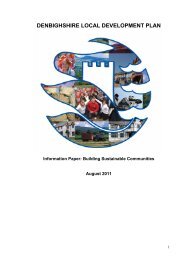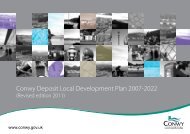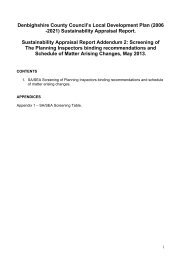HS5-R751 - Denbighshire Local Development Plan
HS5-R751 - Denbighshire Local Development Plan
HS5-R751 - Denbighshire Local Development Plan
Create successful ePaper yourself
Turn your PDF publications into a flip-book with our unique Google optimized e-Paper software.
Residential Property Focus | Q4 2011ForewordWhat next in there-programmedeconomy?Since we made our forecasts last year the worldhas changed, and we are making them this yearviewing a dramatically altered economic outlookOur forecasts for thehousing marketare shaped byforecasts fromOxford Economicsfor economic growth, householdincomes, base rates and all theother variables that go into ourmodel of housing affordability.This host of variables is determinedby their outlook for the globaleconomy. This year, in common withvirtually every other forecaster, theyhave been revising their outlook forgrowth consistently and constantlydownwards. Expectations are now, atbest, for continued lower growth ratherthan the gradual recovery predictedin 2010.So we now find ourselves lookingat a fundamentally altered nationaleconomic backdrop – and also apotentially confusing array of housingmarket indicators saying differentthings. Taken on an annual basis,house price movements in the 12months to September varied accordingto which monitor you looked at.Rightmove said +1.5% while LandRegistry and Hometrack said -2.6%and -3.5% respectively. Our indexfor prime central London propertywas saying +13.6% while our indexof prime regional property showed–2.8%. Clearly, market behaviour hasbeen complex.There are three drivers at work inthe market currently: 1. Overseasequity 2. Wealth created domesticallyand 3. Limited mortgage availability.Prime central London is acting asa safe haven for global wealth so isgrowing. Prime South East marketsand London-centric markets didbenefit from city bonuses and financialsector recovery after March 2009 butare now waning. Elsewhere, there hasbeen essentially no significant recoverysince the markets fell in 2008 andtransactions have been extremely low.So the market has polarised inthree directions: between the equityhaves and have nots, between Northand South and between prime andmainstream. No wonder differentindices are saying different things.Understanding these differences helpsshed light on the market.Asking price indicators reflect theoptimism of vendors rather than theprice at which a property will actuallytransact. This is valuable in revealingthe stickiness of supply that dogs themarket. It shows how turnover is oftenthe first casualty of a falling market assellers withdraw (or let) their propertywhen they can’t achieve a desired price.There is a difference betweentransactions involving a mortgageand those involving equity. Cashtransactions are now a more significantproportion of the market than everbefore. These transactions are notshowing up in every index and aremaking the whole-market samplemeasured by Land Registry verydifferent to what has gone before.Valuation-based indices have arepresentative sample of all stock, notjust the properties that are selling at anyone time. They tend to pick up changeearlier than others which have to waitfor vendor’s expectations to adjustand a transaction to take place. Theseindices outside London have picked upsigns of further falls in property valueand indicate vendors will have to adjusttheir expectations if they want to sell.This forecast issue suggests howmuch these expectations may needto adjust over the next five years indifferent markets. nExecutive summaryThe key findings in this issue■ Most property markets in the UK have not seen therecovery observed in the London-centric markets ofsouthern England and have remained at low levels ofgrowth and/or seen small falls since 2008.■ We expect very low growth in average nominalhouse prices over the next five years. It is inflationthat will continue to strip value from mainstreamproperty over this time.■ In the absence of widespread repossessionsflooding the domestic markets, we see thatturnover will remain the main casualty of thisrecession, with transaction levels staying at theirall-time low level.■ London and southern markets, and particularlyprime markets, are different. They have seen aV-shaped recovery as opposed to the L-shape ofother regions. This is because they are capable ofbeing driven by buyers with large amounts of equityand low reliance on borrowing. The discretionarynature of these purchasers makes these marketsmore volatile however, and buyers withdraw whensentiment fails.■ Prime London is different again as it belongs to adifferent class of world cities. The downside risks inthis market are factors which diminish the creationof global wealth, such as commodity prices andappreciation in the sterling exchange rate. Whileglobal economic turmoil persists and the global richseek a safe-haven store of wealth and a sterlingdenominatedcurrency play, prime central Londonproperty will prosper.Contents04 UK mainstream market06 Market forecasts08 UK prime markets10 Private rented sector12 Housebuilding14 TransactionsYolande BarnesHead of ResidentialResearch020 7409 8899ybarnes@savills.comwww.savills.co.uk/research 03
















